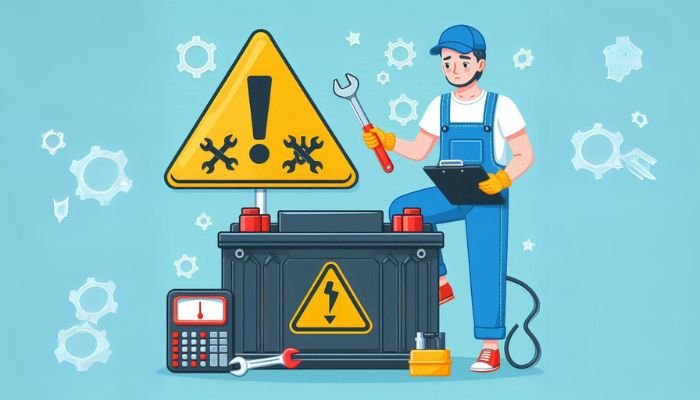A dead car battery is a frustrating experience, but it doesn’t have to ruin your day. This comprehensive guide is packed with expert advice and easy-to-follow instructions, empowering you to diagnose and fix that pesky battery discharge warning.
Whether you’re a DIY enthusiast or prefer to leave it to the pros, we’ve got you covered with everything you need to know to get your car back on the road.
Key Takeaways:
- Understanding is Key: Learn how your car’s electrical system works to better diagnose problems.
- DIY Fixes: Many battery discharge warnings can be resolved with simple steps you can do at home.
- When to Call a Pro: Know the signs that it’s time to seek professional help.
- Prevention: Discover how to keep your battery healthy and avoid future warnings.
Decoding the Battery Discharge Warning
That ominous warning light or message on your dashboard is your car’s way of saying, “Hey, my electrical system isn’t happy!” While it might seem like a minor inconvenience, ignoring it can lead to a dead battery, leaving you stranded.
Common Culprits Behind the Warning:
- Weak or Dying Battery: Just like any battery, your car’s battery has a limited lifespan.
- Faulty Alternator: The alternator is responsible for charging the battery while you drive. If it fails, your battery won’t stay charged.
- Parasitic Draw: This is a sneaky power drain that occurs even when your car is off. It could be a malfunctioning clock, interior lights, or even a faulty aftermarket accessory.
- Loose or Corroded Connections: A poor connection at the battery terminals can prevent proper charging.
Understanding the cause is the first step toward a solution. Let’s delve deeper into your car’s electrical system.
Demystifying Your Car’s Electrical System
Your car’s electrical system is more complex than you might think. Here’s a simplified breakdown:

- Battery: The heart of the system, storing electrical energy to start the engine and power various components.
- Alternator: Driven by the engine, it converts mechanical energy into electrical energy to charge the battery and power electrical systems while the car is running.
- Starter: An electric motor that cranks the engine to get it started.
- Wiring Harness: A network of wires connecting all the electrical components.
- Fuses and Relays: Safety devices that protect circuits from overloads.
- Electronic Control Unit (ECU): The “brain” of the car, controlling various systems and functions.
A healthy battery should read around 12.6 volts when the engine is off. If it’s significantly lower, it could indicate a problem. You can easily check this with a multimeter.
| Battery Voltage | Status |
|---|---|
| 12.6V or higher | Fully charged |
| 12.4-12.5V | 75-100% charged |
| 12.2-12.3V | 50-75% charged |
| 12.0-12.1V | 25-50% charged |
| Below 12.0V | Discharged (needs charging or replacement) |
Understanding these basics will help you troubleshoot the battery discharge warning more effectively.
Simple DIY Fixes: Reclaim Control of Your Battery
Let’s start with the easy fixes you can try before reaching for your mechanic’s number.
If your battery is completely dead, jump-starting might be your only option to get back on the road. However, this is a temporary solution, and you’ll need to investigate the underlying cause of the discharge.
2. Terminal TLC: Tighten and Clean
Corrosion on your battery terminals can disrupt the flow of electricity. Grab a wrench and some baking soda solution to clean those terminals and ensure a secure connection.
3. Voltage Check: Is Your Battery Healthy?
Use a multimeter to check your battery’s voltage. If it’s below 12.4 volts, it’s time for a charge. A battery charger can bring a healthy battery back to life, but if your battery is old or damaged, it might need replacing.
Important Note: Always consult your car’s owner’s manual for specific instructions on jump-starting and working with your battery. Safety first!
Diving Deeper: Advanced Troubleshooting
If the simple fixes didn’t do the trick, don’t despair. Let’s explore some more advanced troubleshooting steps.

1. The Alternator: Your Battery’s Best Friend
A faulty alternator is a common cause of battery discharge warnings. Look for signs like dimming headlights or dashboard lights while the engine is running. If you suspect the alternator, it’s best to have a mechanic test it.
2. Belt Check: Keep Things Tight
The serpentine belt drives the alternator. If it’s loose or worn, your alternator won’t function properly. Check for cracks, fraying, or looseness.
3. The Phantom Menace: Parasitic Draw
Tracking down a parasitic draw requires some electrical know-how. You’ll need a multimeter to measure current flow with the engine off. If you’re not comfortable with electrical work, it’s best to leave this to a professional.
By following these troubleshooting steps, you’ll be well on your way to diagnosing and fixing that pesky battery discharge warning. Remember, safety first! If you’re unsure about any step, don’t hesitate to seek professional help.
Knowing When to Wave the White Flag: Seeking Professional Help
While DIY fixes are empowering, some battery discharge issues are best left to the experts. If you’ve tried the basic troubleshooting steps and the warning persists, or if you encounter any of the following, it’s time to call a mechanic:
- Recurring Battery Problems: If your battery keeps dying even after charging or replacement, there might be a deeper electrical issue.
- Burning Smell or Smoke: These are signs of a serious electrical problem and require immediate attention.
- Multiple Warning Lights: If other warning lights on your dashboard illuminate along with the battery discharge warning, it could indicate a complex issue.
Remember, professional mechanics have the tools and expertise to diagnose and fix complex electrical problems safely and effectively.
Preventing Future Battery Woes: Proactive Care
The best way to deal with a battery discharge warning is to prevent it from happening in the first place. Here are some proactive steps you can take:

- Regular Battery Maintenance:
- Clean the terminals regularly to prevent corrosion.
- Check the battery’s voltage periodically and recharge if needed.
- Have your battery tested by a professional every couple of years.
- Driving Habits:
- Avoid frequent short trips, as they don’t give the battery enough time to recharge fully.
- In cold weather, use a block heater to reduce the strain on the battery during startup.
- Don’t leave accessories like lights and radio on when the engine is off.
- Battery Charger/Maintainer:
- If you don’t drive your car often, consider investing in a battery charger/maintainer to keep the battery topped up.
By taking these preventive measures, you can extend your battery’s lifespan and reduce the likelihood of encountering that dreaded warning.
Frequently Asked Questions
Can I drive with a battery discharge warning?
While you might be able to drive for a short distance, it’s not recommended. The warning indicates a problem with your electrical system, and continuing to drive could lead to a complete battery failure.
How long does a car battery typically last?
The average lifespan of a car battery is 3-5 years. However, various factors like climate, driving habits, and battery quality can affect its longevity.
Is it safe to jump-start a car with a modern computer system?
Yes, it’s generally safe to jump-start a modern car. However, it’s essential to follow the correct procedure and use caution to avoid damaging the sensitive electronics. Refer to your car’s owner’s manual for specific instructions.
What’s the difference between a battery discharge warning and a check engine light?
A battery discharge warning specifically indicates a problem with the battery or charging system. A check engine light, on the other hand, can be triggered by a wide range of issues, including engine misfires, sensor problems, or emission control faults.
How much does it cost to replace a car battery or alternator?
The cost of replacing a car battery can range from $100 to $250, depending on the type and brand. Alternator replacement is more expensive, typically costing between $500 and $1000, including labor.

Thanks for finally talking about >How to Fix a Car Battery Discharge Warning: Your Expert Guide <Liked it! https://odessaforum.biz.ua/
Thank you for taking the time to read and comment on the article! I’m glad you found the guide on fixing a car battery discharge warning helpful. If you have any questions or need further clarification on the topic, feel free to ask. Your feedback is always appreciated!
Thanks for finaloly talking about >How to Fiix a Car Batterry Discharge Warning:
Your Exlert Guide <Liked it! https://odessaforum.biz.ua/
Thank you for taking the time to read and comment on the article! I’m glad you found the guide on fixing a car battery discharge warning helpful. If you have any questions or need further clarification on the topic, feel free to ask. Your feedback is always appreciated!
I do not even know how I ended up here but I thought this post was great I dont know who you are but definitely youre going to a famous blogger if you arent already Cheers
Thank you for your kind words! I’m glad you enjoyed the post. Your support means a lot, and I appreciate you taking the time to leave such a positive comment. If you have any topics you’d like to see covered or any feedback, feel free to share. Cheers!
Its like you read my mind You appear to know a lot about this like you wrote the book in it or something I think that you could do with some pics to drive the message home a little bit but instead of that this is fantastic blog An excellent read I will certainly be back
Thank you for your kind words and feedback! I’m delighted to hear that you found the blog informative and engaging. I appreciate your suggestion about incorporating visuals; I’ll definitely consider that for future posts to enhance the reader experience. If you have any more thoughts or questions, feel free to reach out. I look forward to your next visit!
Techno rozen Pretty! This has been a really wonderful post. Many thanks for providing these details.
Thank you for your kind words! I’m glad you found the information helpful.
Techno rozen This is really interesting, You’re a very skilled blogger. I’ve joined your feed and look forward to seeking more of your magnificent post. Also, I’ve shared your site in my social networks!
Thank you so much for your kind words and support! I’m thrilled to have you on board and appreciate you sharing my site with your network!
Tech to Trick For the reason that the admin of this site is working, no uncertainty very quickly it will be renowned, due to its quality contents.